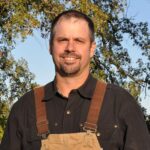My second business trip as director of America’s Conservation Ag Movement (ACAM) took me 1,500 miles from the mostly harvested corn and soybean fields of southeastern Iowa to the annual Sustainable Ag Summit and Dairy Sustainability Alliance fall meetings in Las Vegas. I was excited about the opportunity to renew old acquaintances, discover new partnerships and to meet a few of my new colleagues here at Trust In Food™ in person.
On the plane ride out west, I reopened Aldo Leopold’s “Sand County Almanac” and reread one of my favorite quotes, which framed my view going into the conferences: “There are two spiritual dangers to not owning a farm. One is supposing that breakfast comes from the grocery, and the other that heat comes from the furnace.”
Hosted by Field to Market and the Innovation Center for U.S. Dairy, the Summit brings together hundreds of corporate food and beverage executives and sustainability leaders, as well as representatives from nonprofits, government agencies and universities.
From the opening remarks delivered by Brandon Hunnicutt, a Nebraska farmer and chair of Field to Market, to the three days of presentations, panels and breakout sessions, what pleasantly surprised me was the extent to which the agenda included on-the-ground farmers and ranchers from across the country. This was not my first Sustainable Ag Summit, but I could sense something different, perhaps a renewed and even higher commitment by the organizers to including strong and diverse voices from those working the land and raising families. These producers, through sweat and determination, are innovating and taking risks to do an even better job stewarding the natural resources they have the privilege of managing.
It became clear to me that in the eyes of so many farmers and ranchers, sustainability is defined not only as paying today’s bills but also as providing the next generation with the option of coming back to the farm or ranch. This is a valuable reminder that while continuous improvement remains top of mind, changes in management often require both decades of experience in the rear-view and as well as a long look to the horizon. In other terms, risk and reward calculations are agonizingly contemplated.
I want to highlight two observations that really stood out to me as a fourth-generation farmer and a 20-plus-year conservation professional:
- Day two of the conference featured a tremendously talented producer panel including an almond and grape farmer from California; a cotton and sorghum farmer from Texas; a dairy farmer from Missouri; an egg farmer from Minnesota; a pig farmer from Nebraska; a Somali American farmer from Minnesota; and a rancher from Texas. As you might expect, each had unique insights about overcoming challenges based on their individual journeys. Yet they shared many similarities, including their personal conviction to do more, to share results and to encourage everyone in the room to support them. Texas rancher Meredith Ellis delivered particularly inspiring remarks about her and her family’s commitment to biodiversity and preserving the prairie ecosystem and heritage that their cattle depend upon. I commend these seven producers not only for taking time away from their farm and ranch responsibilities but also for sharing their stories so publicly and articulately.
- As inspiring as these stories are, in my own experience absolutely nothing can replace the level of understanding that results from a personal trip to a farm or ranch. There, you can see the conservation efforts underway and the generational sweat equity and livelihoods of producers in real time. So my challenge to any reader is simply this: If you represent a company or organization that seeks to accelerate environmental programs, ground-truth new visions and ideas by bouncing around in a UTV across the fields with producers you seek to help. On the flip-side, if you are a farmer or rancher and the thought of being on stage in front of hundreds isn’t your definition of fun, extend an invitation for someone to join you in the tractor’s buddy seat so they get firsthand experience and a chance to hear about your life on the land.
I am completely optimistic and excited about the direction and opportunities of advancing sustainable agriculture. Together, we can bring varied and, at times, conflicting viewpoints together for innovative public-private partnerships, new revenue streams and, ultimately, greater conservation of our soil, water and biodiversity. I type this not as the director of ACAM but rather as the proud father of two kids whom my wife and I are fortunate to raise on our family’s farm on the banks of the Mississippi River. We owe them the opportunity to be the fifth generation. If you’ve read this far, you have a standing invitation to ride along in the buddy seat of our tractor or combine if you’re ever in south-east Iowa.



